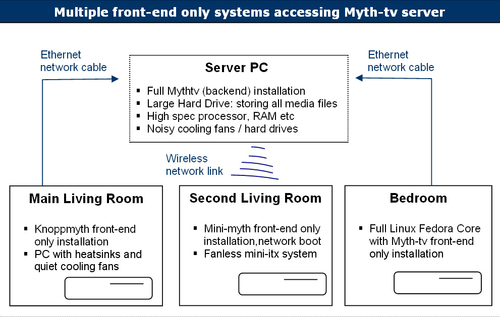|
LinHES
LinHES (Linux Home Entertainment Server) is a Linux distribution designed for use on Home Theater PCs (HTPCs). Before version 6, it was called KnoppMyth. The most recent release (R8), for 64-bit machines only, is based on Arch Linux, though previous versions were based on Knoppix and Debian. LinHES includes custom scripts that install and configure the MythTV PVR software as well as a number of add-ons. Most standard HTPC hardware is supported, and much of it is even configured automatically, making the often complex installation and configuration process relatively easy and pain-free. Cecil Watson developed and maintains the LinHES operating system. DetailsPractical explanationLinHES is a Linux distribution equivalent to the Windows Media Center. LinHES comes as a CD-ROM software distribution which automates the setup of the popular MythTV package as well as several HTPC-related add-ons. Ultimately, LinHES is used to create a home theater PC. These HTPCs are commonly plugged into a standard-definition television (SDTV) or high-definition television (HDTV) rather than monitors for a complete home theater experience. HTPCs bring the power of PCs to the living room in an "all in one" device. Ease of installation and featuresA common complaint about MythTV is that it is difficult and time-consuming to install and configure. The goal of LinHES is to make creating and maintaining a home theater PC as simple as possible. A blank system can be transformed to a fully functional HTPC in around 20 minutes[citation needed] capable of:
ApplicationsComplete Installation (Front-end and Back-end)LinHES can be used to install a full MythTV client and server system. This means that the front-end is stored on the same device as the back-end. The front-end is the software required for the visual elements (or the GUI) that the regular user can utilize to find, play and manipulate media files etc. The back-end is the server where the media files are actually stored. A full front-end and back-end system may have an advantage in that it has 'portability', i.e. it is a standalone device that is not dependent on a separate server (like a video game console for example). Front-end only installations Alternatively, LinHES can be used to install a MythTV client, front-end-only system. For example, users may have a central storage device (server) in their house, the server can then be accessed from numerous other devices throughout the house, these other devices needing only a front-end installation on devices containing minimal hardware. LinHES can also run directly from a CD-ROM (i.e. without installation) providing that there is a network connection to a PC with a 'complete installation' (a MythTV back-end server). Using a 'server' separate from one or more front-end units has the obvious advantages of multiple simultaneous access to shared media files. The server used would generally have hardware of a relatively high specification and would be kept outside of the main living room. An advantage of keeping the server PC outside the living room is that the cooling fan required to accommodate a 'fast' processor can be quite noisy (as can certain hard drives), it can be expensive to invest in fanless/heat sinking equipment to avoid such noise problems. LinHES can also be used to upgrade existing LinHES and KnoppMyth installations. LinHES communityLinHES users generally discuss ideas and help others at the official forum website. Version historyLinHES R7.4 was the last 32-bit release.[2] KnoppMyth releases
LinHES releases
See alsoReferences
External links
|